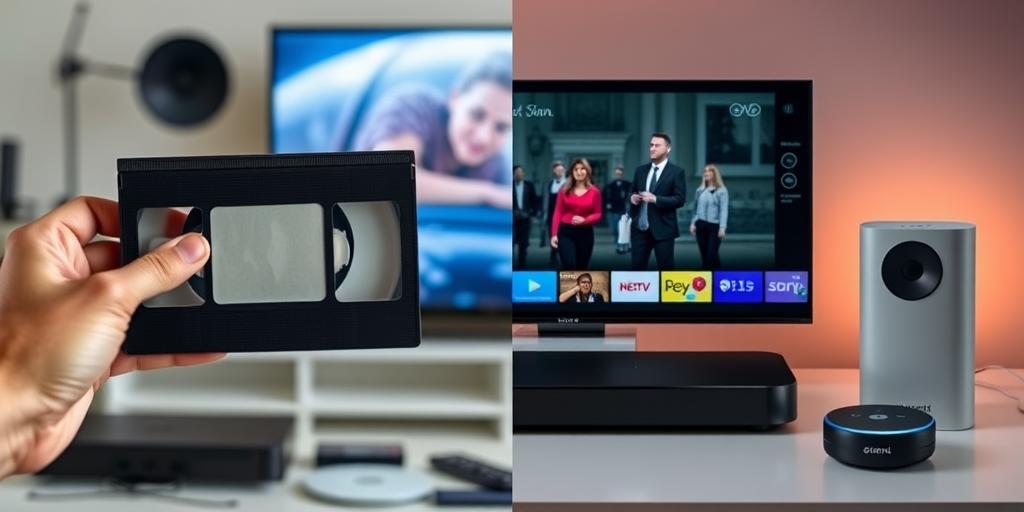Imagine a world without the convenience of watching your favorite movies and shows at home. It’s hard to believe, but the journey of home entertainment has been a long and fascinating one, shaping our lives and influencing the way we consume media. From the bulky VCRs of the past to the sleek streaming devices of today, the evolution of home entertainment is a testament to human ingenuity and the ever-changing landscape of technology. Let’s delve into the history of home entertainment and explore the forces that have propelled its incredible transformation.
The Rise of Home Entertainment
The Dawn of the VCR: A Revolution in Viewing Habits
The advent of the VCR in the 1970s marked a turning point in home entertainment. Before this, television viewers were limited to broadcast schedules. The VCR allowed individuals to record programs and watch them at their convenience, ushering in an era of greater control over viewing habits. This groundbreaking invention paved the way for a new era of home entertainment, where viewers could access a wider range of content, from classic films to newly released blockbusters.
The Golden Age of VHS: Blockbusters and Cult Classics
The 1980s saw the rise of the VHS format, becoming the dominant force in home entertainment. The affordability and widespread availability of VHS tapes made it possible for everyone to enjoy movies and TV shows at home. This period marked a golden age for home entertainment, with blockbuster hits and cult classics finding their way into living rooms across the globe. From iconic films like “E.T. the Extra-Terrestrial” to cult classics like “The Breakfast Club,” VHS tapes became a cherished part of pop culture, fostering a sense of nostalgia that continues to resonate today.
The Digital Revolution: From DVDs to Streaming
The Convenience of DVDs: A New Era of Home Cinema
The arrival of the DVD in the late 1990s brought about a significant improvement in picture and sound quality, offering a more immersive home cinema experience. DVDs offered a range of interactive features, such as special features, director’s commentary, and multiple language options. The convenience of DVDs, along with their superior quality, made them a popular choice for home entertainment, replacing VHS tapes as the dominant format.
The Rise of Streaming Services: On-Demand Entertainment at Your Fingertips
The early 2000s saw the emergence of the internet and the rise of streaming services. Netflix, founded in 1997, initially operated as a DVD-by-mail service, but quickly transitioned to streaming. The convenience and vast libraries of streaming services quickly gained traction, offering on-demand access to a wide range of movies, TV shows, and original content. This shift marked a major paradigm shift in home entertainment, making it more accessible, convenient, and personalized.
The Impact of Streaming on the Entertainment Industry
The Decline of Traditional Media: Cable TV and Movie Theaters Face Challenges
The rise of streaming services has had a profound impact on the entertainment industry. Cable television and movie theaters have faced significant challenges as consumers increasingly turn to streaming platforms for their entertainment needs. The convenience and affordability of streaming services have led to a decline in traditional cable subscriptions and movie theater attendance.
The Rise of Independent Content Creators: New Opportunities for Storytelling
While traditional media has faced challenges, the rise of streaming services has also created new opportunities for independent content creators. Platforms like YouTube, Twitch, and TikTok have empowered individuals to create and distribute their own content, reaching a global audience. This democratization of content creation has led to a surge in independent films, documentaries, and web series, diversifying the landscape of home entertainment and offering viewers a wider range of perspectives and stories.
The Future of Home Entertainment: What Lies Ahead?
The Evolution of Streaming Technology: 4K, VR, and Beyond
The future of home entertainment is likely to be driven by advancements in streaming technology. 4K resolution is becoming increasingly common, offering viewers a more immersive and visually stunning experience. Virtual reality (VR) is also poised to play a significant role, offering interactive and immersive entertainment experiences. These advancements are expected to blur the lines between the physical and digital worlds, creating new possibilities for engagement and entertainment.
The Importance of Personalized Content: Tailored Recommendations and User Experiences
The future of home entertainment will likely focus on personalization. Streaming services are already using algorithms to recommend content based on user preferences, creating a tailored experience for each individual. This trend is likely to continue, with platforms using artificial intelligence (AI) to further refine their recommendations and provide a more personalized and engaging experience.
The Role of Artificial Intelligence: Enhancing Entertainment and User Engagement
AI is poised to play a transformative role in the future of home entertainment. It can be used to personalize content recommendations, create immersive experiences, and enhance user engagement. AI-powered chatbots can provide instant support and answer queries, while AI-driven voice assistants can be used to control devices and navigate through streaming services. The integration of AI is expected to further revolutionize the way we consume and interact with entertainment.
The journey of home entertainment has been marked by innovation, disruption, and a constant quest for better and more immersive experiences. From the early days of the VCR to the era of streaming, the evolution of home entertainment has fundamentally changed the way we consume media. Looking ahead, the future of home entertainment is bright, with technological advancements, personalization, and AI poised to further transform our entertainment experiences. The possibilities are endless, and the future of home entertainment promises to be even more exciting and engaging than ever before.




